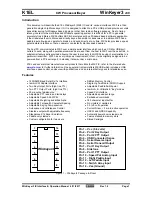
I.B. 48008
Page 10
Effective 11/97
Synchronous Motor Check
Each Mark V synchronous motor controller has a terminal
strip consisting of seven studs on standoff insulators
mounted on a subpanel and labeled as shown in Figure 8.
Disconnect leads from these stabs as necessary to
conduct the following tests:
1.
With the motor slip rings clean and brushes down (in
operating position) measure and record the cold motor
field resistance between F1 and F2. Calculate the
field resistance by dividing the nameplate field voltage
by the nameplate field current. The measured ohms
should be between 70 and 80 percent of calculated
ohms. If the measured resistance at the terminal strip
(F1 and F2) is more than 80 percent of calculated
resistance measure the field resistance at the motor
slip rings. This latter reading should be less than the
previous reading. If resistance readings are still high
determine cause.
2.
With the motor field disconnected verify that the
resistance between F1 and F2 on the terminal strip is
250 ohms, + 15 ohms.
3.
Measure the resistance of the starting and discharge
resistor (S/D RES on schematic diagram, Figure 4) at
terminals R1 to R3 on the terminal strip (Figure 8).
The measured value should be as shown on the
diagram accompanying the order. Measure the
resistance between terminals VR and KA1 on the
synchronous control board (CB). The reading should
be 50 ohms + R1-R3 value.
4.
Reconnect all leads.
Controller Check
1.
Verify that the jumpers required for the installation are
properly installed. See Table II.
2.
Read the ampere ratings of the three fuses supplied
on the secondary side of the transformers providing
power to the solid-state controller.
These fuse ratings are equal to the ampere rating of
the field power supply.
3.
Verify the dial setting of the FLA relay located adja-
cent to the synchronous control board (Fig. 3). This
dial setting should equal 40% of the motor nameplate
field current divided by the ampere rating of the field
power supply.
Fig. 8 Cubicle Terminal Strip






























